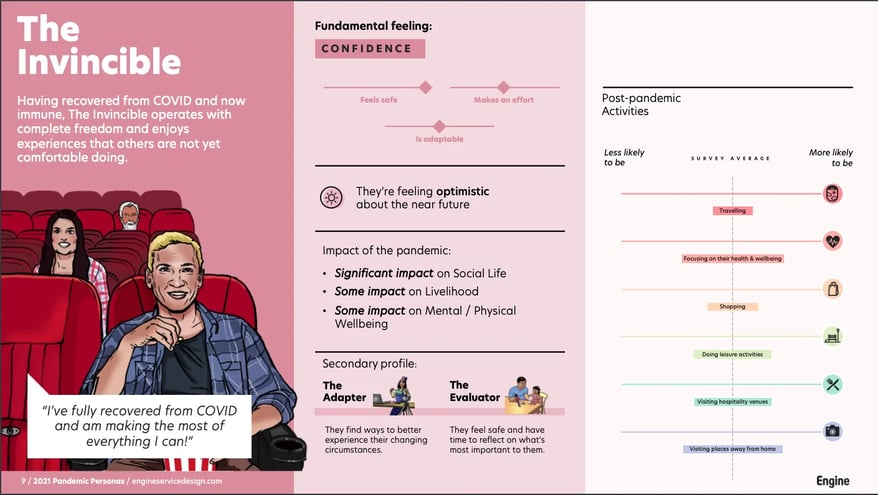Get in touch
How to create the right customer experience strategy for your organisation

In today's competitive business landscape, it's no longer enough to simply offer a product or service – you need to create a memorable customer experience that sets you apart from the rest. This is where a customer experience (CX) strategy comes into play.
A well-defined CX strategy can help you build customer loyalty, increase revenue, and boost brand awareness. In fact, recent research indicates that 61% of consumers are willing to pay more if they know they’ll get a good customer experience and, what’s more, CX drives over two-thirds of customer loyalty - that’s more than brand and price combined!
So, it’s clear that a well-defined CX strategy is worth the effort. But, with something as holistic as customer experience, where do you get started?
In this blog post, we'll explain how to create the right CX strategy for your organisation by focusing on your CX vision, defining your customer personas, identifying key touchpoints, and setting CX goals.
Define Your CX Vision
Before you can create a CX strategy, it's crucial to define your CX vision. Your CX vision is the overarching goal that guides your CX strategy. It should be specific, measurable, and achievable, and it should align with your overall business goals and reflect your brand values.
Defining your CX vision is important because it helps you to establish a clear direction for your CX strategy, and ensures that everyone in your organisation understands and works towards the same goal. Some examples include:
Exceptional service
According to a study by American Express, 78% of consumers have bailed on a transaction or not made an intended purchase because of poor service. What’s more, 50% of customers will switch to a competitor after just one bad experience. Therefore, if your CX vision is to provide exceptional service, you'll need to ensure that every touchpoint with your customers is designed to meet and exceed their expectations. This might involve investing in training for your customer service team, improving your website's usability, or offering personalised recommendations to customers.
Personalised customer experiences
Another example of a CX vision is creating personalised experiences. Research by Epsilon indicates that 80% of customers are more likely to make a purchase when brands offer personalised experiences. So, if your CX vision is to create personalised experiences, you'll need to focus on understanding your customers' needs and preferences. This might involve collecting data about your customers' buying habits, creating customer personas, or using artificial intelligence to offer personalised recommendations.
Define Your Target Customer
Once you have identified your CX vision, you need to understand your target customer. This is the person who is most likely to buy from you, and who you want to attract and retain.
One way to define your target customer is to create a customer persona - a fictional representation of your ideal customer, based on data and research. It includes information about their age, gender, income, interests, and buying habits. By creating a customer persona, you can better understand your target customer's needs, preferences, and pain points, and tailor your CX strategy to meet their specific requirements.
To get started, you'll need to gather data about your existing customers and conduct research to identify patterns and trends. We recommend taking the following steps:
- Conduct customer research: Conduct surveys, interviews, or focus groups to gather data about your existing customers. Ask questions about their demographics, interests, and buying habits.
- Identify patterns and trends: Analyse the data you have collected to identify patterns and trends. Look for commonalities in your customers' demographics, interests, and buying habits.
- Create customer segments: Use the patterns and trends you have identified to create customer segments. These segments should represent different groups of customers who share similar characteristics. For example, we created our Pandemic Personas Pack in 2021, which outlines 11 different personas based on customer needs and attitudes when dealing with the pandemic. Some examples are below::
- THE EMERGER: Having sheltered or lived extremely cautiously for almost a year, The Emerger, now vaccinated, is engaging in everyday activities with more confidence and is enjoying experiences they have abstained from or been denied.
- THE INDEPENDENT: Whilst aware of the guidelines, The Independent manages the risk of catching or transmitting COVID on a case-by-case basis relying upon their judgement and experience to stay safe.
- THE INVINCIBLE: Having recovered from COVID and now immune, The Invincible operates with complete freedom and enjoys experiences that others are not yet comfortable doing.

Identify Key Touchpoints
Now you've defined your target customer, you need to identify the key touchpoints where your customer interacts with your brand. Touchpoints are any point of contact between your customer and your brand, such as your website, store, product, or customer service. Identifying these interactions will help you understand how your customer experiences your brand, and where you can make improvements to enhance their experience.
To identify key touchpoints, start by mapping out the customer journey using an online tool like Miro or Whimsical; this is the path that your customer takes from initial contact with your brand to purchase and beyond, and includes all touchpoints that the customer interacts with along the way.
For example, if you are a retail store, your key touchpoints might include your website, your store location, your product displays, and your customer service. It’s important to approach the process objectively and from the customer’s perspective, so make sure to use data you have collected from your customers in surveys and from interactions you’ve had with them to identify where to focus.
By mapping out the customer journey and prioritising key touchpoints, you can gain a clearer understanding of the overall customer experience and identify areas for improvement. Once you have identified these areas, you can make targeted changes to enhance the customer experience and ultimately drive business growth.
Set CX Goals
Next, it's time to set CX goals. Start by reviewing your CX vision, target customer, and key touchpoints, and identify areas where you can make improvements to enhance the customer experience.
Then, set specific goals for each area of improvement. For example, if you have identified website usability as an area for improvement, a specific goal might be to reduce website bounce rates by 10% within the next six months.
It’s important to make sure that your goals are measurable. This will help you to track your progress and measure the effectiveness of your CX strategy. For example, you might measure website bounce rates using Google Analytics.
Your goals should also be achievable within the resources and capabilities of your organisation - make sure to set realistic timelines and allocate resources accordingly.
By setting specific, measurable, and achievable CX goals that align with your CX vision and reflect your target customer's needs and expectations, you can create a CX strategy that delivers a memorable customer experience and sets you apart from the competition.
Develop Your CX Strategy
Once you've defined your CX vision, target customer, key touchpoints, and CX goals, it's time to develop your CX strategy.
To create the right CX strategy for your organisation, you need to identify the memorable moments that your customers will associate with your brand. These moments can be the result of exceptional customer service, personalised interactions, or unique experiences that stand out from the competition.
Once you've identified these memorable moments, you can then work on delivering them consistently across all touchpoints. Your CX strategy should detail how you plan to create these signature experiences and when and where you will deliver them. This could involve developing a comprehensive training program for your employees, implementing new technology or tools to enhance the customer experience, or investing in customer feedback mechanisms to continuously improve your CX strategy.
Ultimately, creating a successful CX strategy requires a customer-centric approach that puts your customers at the centre of everything you do. By prioritising their needs and expectations, you can build a strong brand reputation, drive customer loyalty, and ultimately achieve your CX goals.
At Engine Service Design, we help organisations across a range of industries design remarkable services and experiences their customers will love.
If you're interested in learning more about how Engine Service Design can help you create the right CX strategy for your organisation, click below to get in touch. We’d love to chat with you about how we can help you create consistent, personalised customer experiences that truly make a difference.
Meeting the expectations of today’s consumers: 10 service design fundamentals
Advancements in technology, such as smartphones, modern web technologies, cloud computing, APIs,...Why digital is no longer enough to create value and differentiate your customer experience
Cast your mind back just a few years and the digital customer experience some companies delivered...What is customer experience and why is it important?
In today’s competitive market, and as a result of changing consumer expectations, it is not enough...Book time with a service design expert.
Discover the transformative power of service design and unlock the full potential of your business. Get in touch with our service design experts today and start improving or innovating your services and customer experience.
